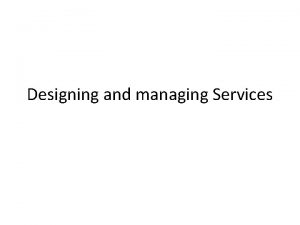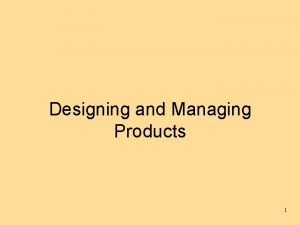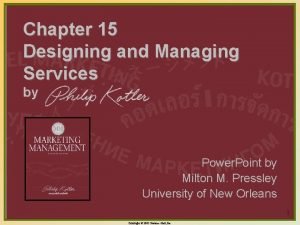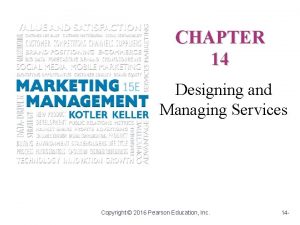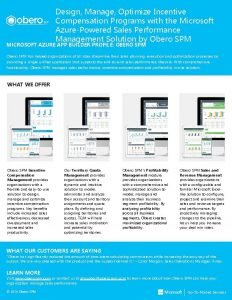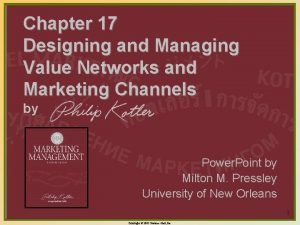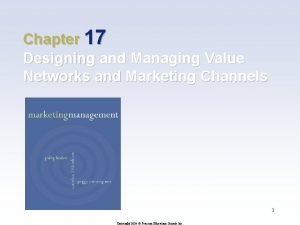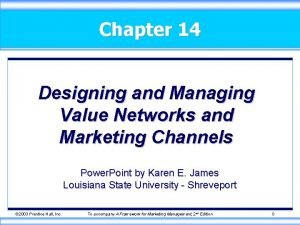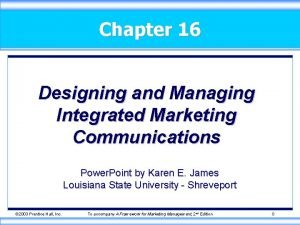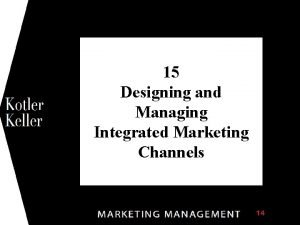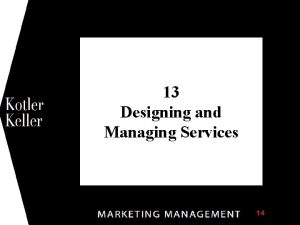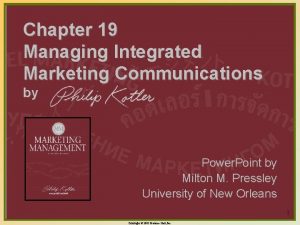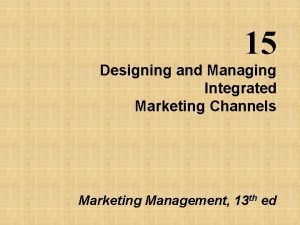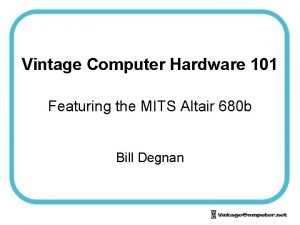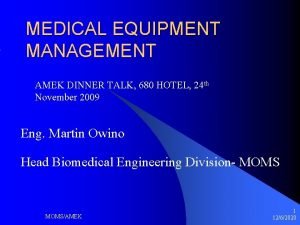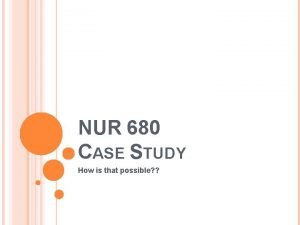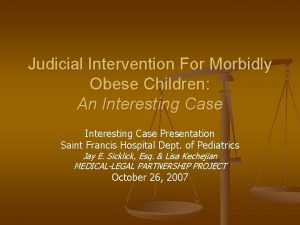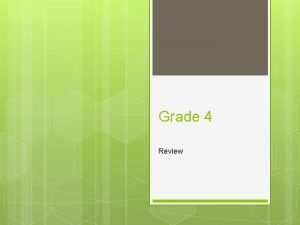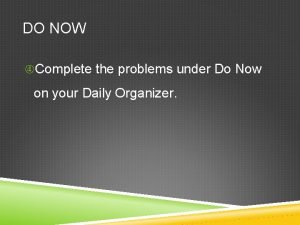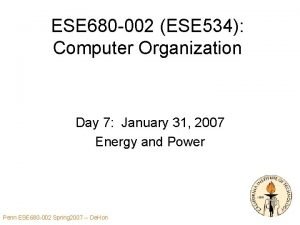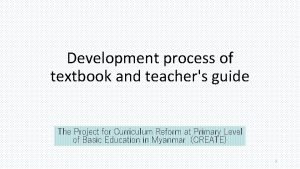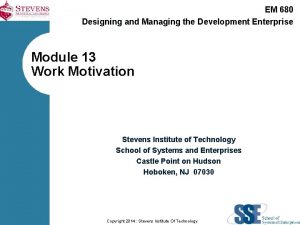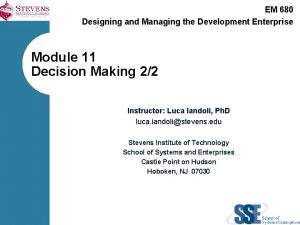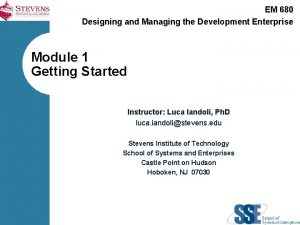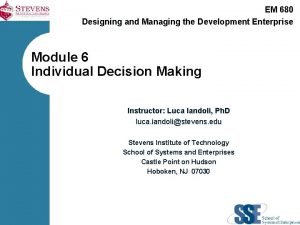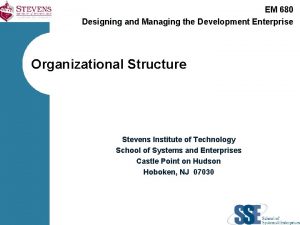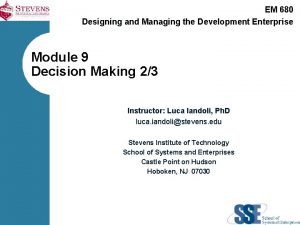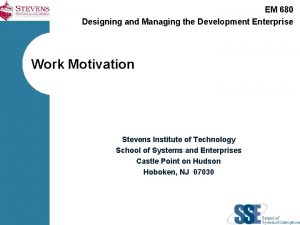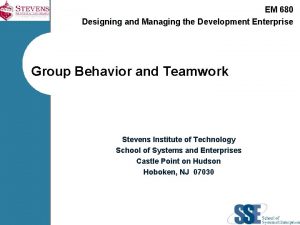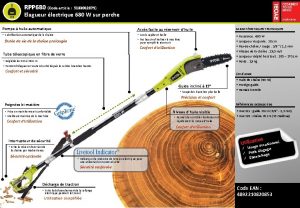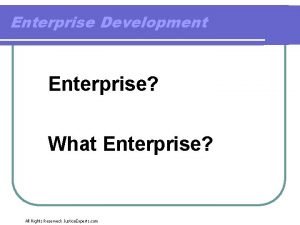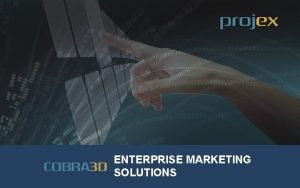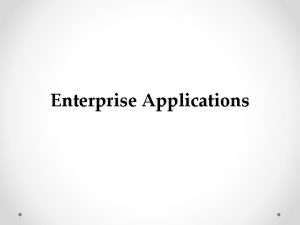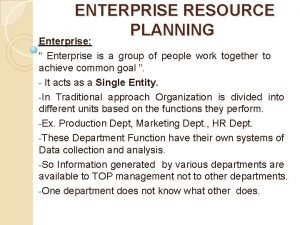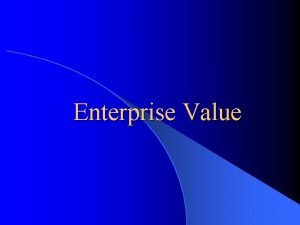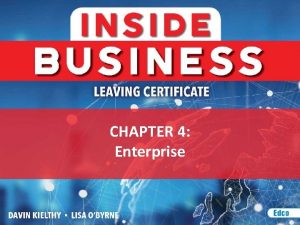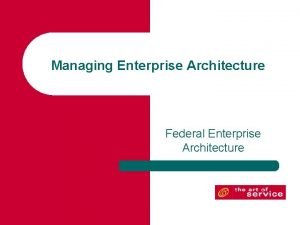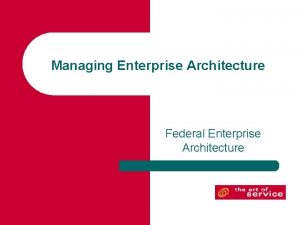EM 680 Designing and Managing the Development Enterprise




























- Slides: 28

EM 680 Designing and Managing the Development Enterprise Module 10 Individual Decision Making Instructor: Luca Iandoli, Ph. D luca. iandoli@stevens. edu Stevens Institute of Technology School of Systems and Enterprises Castle Point on Hudson Hoboken, NJ 07030

Knowledge Objectives Describe the basic steps in decision making. Individual decision making (this module): 1. 2. - 3. 4. Rational Decision Making VS Decision in the Wild Define cognitive bias and explain the effects of common types of cognitive bias on decision making Discuss the four decision-making styles, emphasizing the effectiveness of each one Group decision making: pitfalls and techniques (module 11) Organizational decision making (module 12) This presentation contains multiple references to your textbook, Hitt, M. A. , C. C. Miller, and A. Colella. (2009). Organizational Behavior: A Strategic Approach. Hoboken, NJ: Wiley & Sons.

Decision-Making Process Define the Problem Identify Criteria Gather and Evaluate Data 1. List and evaluate alternatives 2. Select best alternative 3. Implement and follow up List and Evaluate Alternatives Select Best Alternative Implement and Follow Up Decisions: Choices of actions from among multiple feasible alternatives Copyright 2014 : Stevens Institute Of Technology

Decision-Making Process Define the Problem Identify Criteria Do individuals, groups or organizations really make Gather and Evaluate Data decisions in this way? List and Evaluate Alternatives Select Best Alternative Implement and Follow Up

How we decide! We are given the following profile: Luigi is 34 years old. He is smart but not very creative, likes routine and he does not have a very active lifestyle. In school he was good at math, but did not like humanities Which is the most likely option among the following: A- Luigi is a doctor and likes playing poker B- Luigi is an architect C- Luigi is an accountant D- Luigi plays jazz music E- Luigi likes wind surf F- Luigi is a journalist G- Luigi is an accountant and he likes playing chess H- Luigi likes hiking

How we decide! You’re the manager of a chain of nine department stores and you are required to make a forecast of the amount of sales for the next month. All stores are the same in terms of size and market served, and differences between stores may be due to random factors. You are give the sales data for the previous month. Make a forecast by store given that it is expected a 10% increase in the overall sales Store current month 1 12000 2 11500 3 11000 4 10500 5 10000 6 9500 7 9000 8 8500 9 8000 TOTAL 90000 next 99. 000

How we decide! l What happened? – – Real decision makers are not rational, or at least not as rational as traditional decision science assumes We use heuristic shortcuts to make guesses instead than engaging into probability computation or logical reasoning

How we decide! l Examples of decision heuristics – – – Availability heuristic: we judge likely what is close to our stereotypes and ignore base frequency (in a random sample of working population which is the likelihood to pick up an accountant choosing at random? E. g. only 1% are accountants) Anchoring: our estimates are influenced by existing information, again we ignore that a given data point may be a random point (sales in a given month for identical stores) … and many others http: //en. wikipedia. org/wiki/List_of_cognitive_biases

How we decide! l Are we stupid? Are heuristics wrong? – – Yes, from the traditional decision theory point of view, but they work pretty well in many day-byday decisions

How we decide bookshelf

How we decide Gut feeling and snap decision In the heat of the Persian Gulf War, Royal Navy Lt. Cmdr. Michael Riley was manning a shipboard radar station when he picked up a blip showing something heading toward the Missouri [an US aircraft carrier]. The projectile had the profile of both an incoming coalition A 6 aircraft and an enemy Silkworm missile. Riley had no criteria for deciding between the two and was tortuously suspended between the possibilities of allowing a strike and blasting his brothers-in-arms out of the sky. But, Riley said, "There was something strange about this radar blip. It didn't feel like an A-6. "On gut feeling, Riley gave the order to shoot down …

How we decide Gut feeling and snap decision … what turned out to be an enemy missile! After hours of analysis, the officer and a cognitive psychologist resolved that his feeling was a subliminal recognition that the missile entered his screen at a slightly different interval from the planes he was used to tracking.

How we decide Gut feeling and snap decisions • Decision as pattern recognition • Role of pre-existing knowledge (mental models) and expectations • Good mental models are not created by chance but by thousand of hours of deliberate practice! (see the controversial “ 10, 000 hours of practice” study by Ericsson et al, Psychological Review, 1993)

How we decide Who’s this guy?

How we decide Gut feeling and snap decisions

How we decide Gut feeling and snap decisions A man and his son are in a serious car accident. The father is killed, and the son is rushed to the emergency room. Upon arrival, the attending doctor looks at the child and gasps, “This child is my son!” Who is the doctor?

How we decide Gut feeling and snap decisions Two different ways the brain forms thoughts: • System 1: Fast, automatic, frequent, emotional, stereotypic, subconscious ü System 1 thinking involves associating new information with existing patterns, or thoughts, rather than creating new patterns for each new experience • System 2: Slow, effortful, infrequent, logical, calculating, conscious ü System 2 thinking involves reflection, speculation, deduction and creativity

How we decide Gut feeling and snap decisions The Mann Gulch Disaster Weick, K. (1993), The Collapse of Sensemaking in Organizations: the Mann Gulch Disaster, Administrative Science Quarterly, 38: 628 -652

How we decide Decision making under stress: why some people choke and other panic Stress System 1 (think fast) System 2 (think slow) Repeat obsessively the most natural answer to the situation (“Run!”) Rationalize, stop and reflect PANIC http: //gladwell. com/the-art-of-failure/ CHOKE

How we decide The role of emotions and the biology of decisions René Descartes was wrong: mind and body, rationality and emotion are not separated Damasio's theory stresses 'the crucial role of feeling in navigating the endless stream of life's personal decisions. . The intuitive signals that guide us in these moments come in the form of limbic-driven surges from the viscera that Damasio calls "somatic markers" - literally, gut feelings’. Listening to your gut reactions, 'the somatic marker. . . may lead you to reject, immediately, the negative course of action and thus. . . allows you to choose from among fewer alternatives '. http: //en. wikipedia. org/wiki/Descartes'_Error

How we decide The role of emotions and the neurology of decisions The story of Elliot How a brain injury hampered Elliot’s capability to make even the simplest decision (e. g. scheduling an appointment) And how Damasio proved that this deficit was determined by Elliot’s incapability (due to the injury) to feel any type of emotion http: //www. smh. com. au/national/feeling-our-way-to-decision-20090227 -8 k 8 v. html

How we decide Storytelling and the narrative fallacy The narrative fallacy addresses our limited ability to look at sequences of facts without weaving an explanation into them, or, equivalently, forcing a logical link, an arrow of relationship upon them. Explanations bind facts together. They make them all the more easily remembered; they help them make more sense. Where this propensity can go wrong is when it increases our impression of understanding. —Nassim Nicholas Taleb, The Black Swan

How we decide Storytelling and the narrative fallacy l Before an unexpected event happens – l Stories may hamper our ability to see facts that are not coherent with the story After an unexpected event has happened – We build a story to accommodate the event (“how could we be so fool to not see that it was going to happen? ”)

How we decide Storytelling and the narrative fallacy l The jury decision model (Pennington and Hastie) – In a series of empirical studies on jurors’ DM in legal trials Pennington and Hastie found that jurors tended to discount substantial pieces evidence when these could not be wrapped-up easily into a convincing, straightforward narrative

Decision-Making Styles l Individual’s predispositions can affect decision process at two critical stages – Gathering (Perceiving) of information l l – Sensing style Intuition style Evaluating (Judging) of alternatives l l Thinking style Feeling style

Using the five senses to identify factual details Intuition Using abstractions and describing the “big picture” “Scientists” “Marketers” Sensing Decision-Making Styles “Accountants” “Artists” Thinking Feeling Using objective analysis and rational procedures Using subjective values with emotional and personal factors

Decision-Making Styles l Why decision styles may matter? – – Job/person tasks: assign tasks in a way that they are consistent with the dominant decision approach of an individual Mind stretching: ability to switch between decision style to see the problems from different points of view

Wrap-up l l Levels of Decision making (individual, group, organizations) The way individuals actually make decisions in real-life situations is not accounted for by traditional DM theory Behavioral economics, cognitive science and neurobiology studies have provided many insights on how people make decisions These findings can help to improve DM effectiveness in organization (next lecture)
 Designing and managing service
Designing and managing service Designing and managing products
Designing and managing products Designing and managing services
Designing and managing services Designing and managing services ppt
Designing and managing services ppt Designing and managing marketing communications
Designing and managing marketing communications Obero spm
Obero spm Managing channel dynamics
Managing channel dynamics What is a marketing channel system and value network
What is a marketing channel system and value network Designing and managing value networks
Designing and managing value networks 7 types of jaycustomers
7 types of jaycustomers Designing and managing integrated marketing communications
Designing and managing integrated marketing communications Designing and managing integrated marketing channels
Designing and managing integrated marketing channels Designing and managing integrated marketing channels
Designing and managing integrated marketing channels Managing integrated marketing communications
Managing integrated marketing communications Designing and managing services
Designing and managing services Designing and managing integrated marketing communications
Designing and managing integrated marketing communications Designing and managing integrated marketing communications
Designing and managing integrated marketing communications Mits altair 680
Mits altair 680 Talk 680
Talk 680 F tag 842
F tag 842 Bme 680
Bme 680 Ese 680
Ese 680 Nur 680
Nur 680 Christina 680 pounds
Christina 680 pounds 260 in word form
260 in word form Ese 680
Ese 680 A 680 newton student runs up a flight of stairs
A 680 newton student runs up a flight of stairs Ese 680
Ese 680 Textbook development process
Textbook development process
